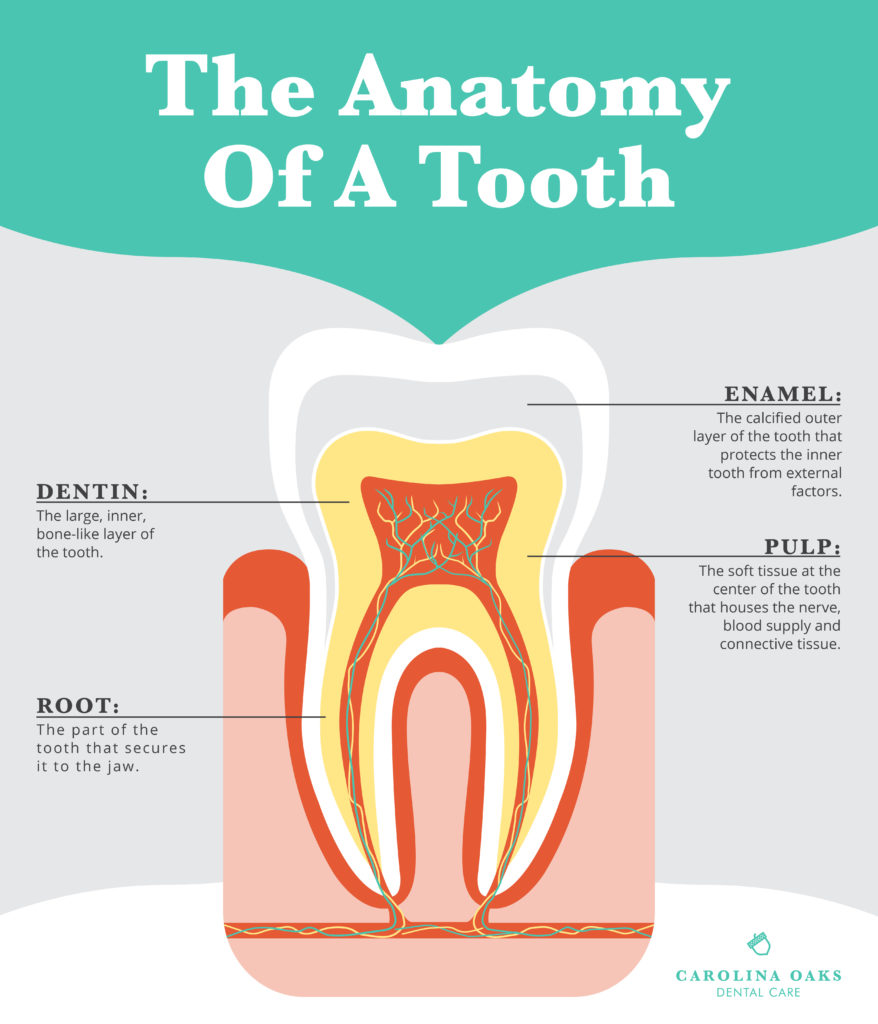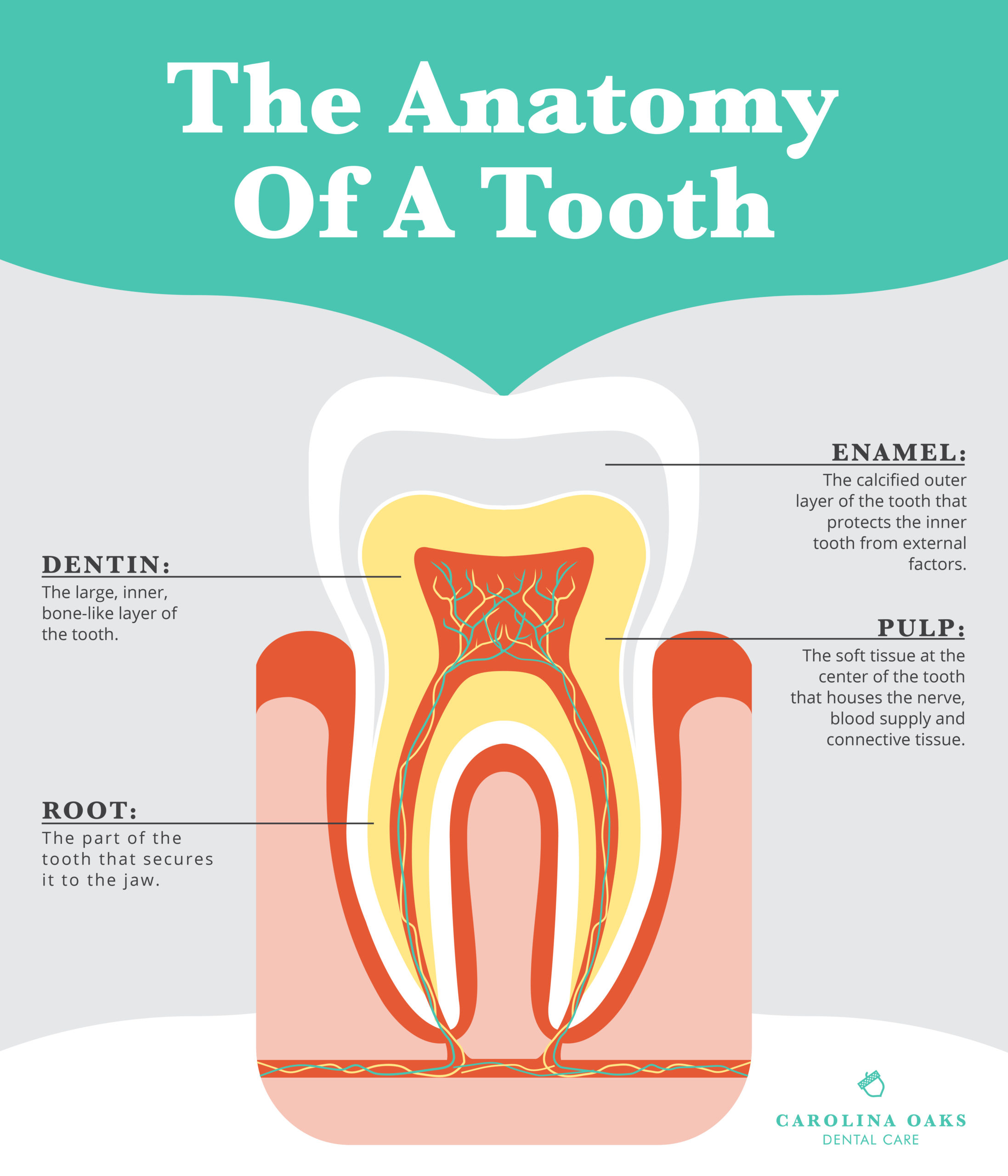
We use them for chewing and eating. They help us swallow our food and speak clearly. They support our facial structure and form the foundation of our smiles. But do you really know what your teeth are made of? Consider this your tooth anatomy lesson! In this post, the Oconee Dental Associates team will answer any questions you’ve ever had about your teeth, including:
- How teeth develop
- The parts of a tooth
- The different types of teeth
- How teeth work together
The Development of a Tooth
We are all born with a full set of primary teeth, 10 on the top and 10 on the bottom. That’s right, your teeth start to develop in utero, long before you’re born. The first stage begins at around six weeks of pregnancy, and then the hard tissue that surrounds the teeth forms at around three to four months. At birth, all of your baby teeth are fully formed, hidden beneath your gums. For most babies, teeth begin to erupt through the gums between six and 12 months of age. (This is the perfect time for your child’s first dental visit!)
At about six years of age, your baby teeth begin to loosen and fall out, making space for your permanent adult teeth to come in. Did you know that adults typically have 12 teeth more than babies and kids? That’s because children’s mouths are not big enough to accommodate all of the teeth we need as adults. While we only have 20 teeth as kids, we end up with 32 teeth as adults (unless, of course, you have any teeth pulled, such as the wisdom teeth). Your permanent teeth begin to develop in your jaw at birth. Most people have 28 of their permanent teeth by age 14 with the wisdom teeth developing in the late teens and early 20s.
The Parts of a Tooth
So what are teeth made of? Each tooth is composed of four main parts: the enamel, the dentin, the pulp and the root. Let’s look at each part in detail.
- Enamel: This is the outer layer of the tooth, the part that we can see from the outside. Tooth enamel, which is the hardest material in the body, is made mostly of calcium phosphate. Since enamel contains no living cells, it cannot regenerate or regrow, so it’s important to take good care of your enamel to keep your teeth strong!
- Dentin: The largest part of the tooth is its inner layer, called dentin. This bone-like material is made up of microscopic tubules that, without proper protective covering from the enamel, can allow cold or heat to pass through to the nerves and cells within the tooth, causing sensitivity and pain.
- Pulp: The pulp of the tooth is the soft tissue at the center that houses the nerve, blood vessels and connective tissue. These blood vessels carry nutrients to the tooth.
- Root: The root is the part of the tooth within the bone socket that secures the tooth to the jaw.
Types of Teeth and What They Do
You’ve no doubt noticed that your teeth do not all look the same. Your front teeth are flat and thin, whereas your back teeth are shorter and have larger surface areas. Within our full sets of teeth, we have several different types of teeth that help support various essential functions. Here’s what they are and how they work together to help you chew, eat, swallow, speak and show off your beautiful smile.
- Incisors: The front four teeth in both the upper and lower jaw are your incisors. They are sharp, flat and have a thin edge to make it easier to bite into food and cut it into smaller pieces. The four central incisors are the two center teeth on both the top and bottom, and you have one lateral incisor on either side of each set of central incisors. These are typically the first teeth we get as kids, and both children and adults have all eight incisors.
- Canines: Starting from the center and working our way towards the back of the mouth, your canines come next. These are the sharp, pointy teeth that sit next to your lateral incisors and, true to their name, look kind of like fangs. The longest of all of your teeth, your canines are meant for tearing food. Both children and adults have all four canine teeth.
- Premolars: Larger than the incisors or canines, premolars sit next to the canines but do not come through until around age 10 to 12. These teeth are wider and have ridges on their chewing surfaces, helping us grind up and chew food down so we can swallow. Once they appear as adult teeth, we have eight premolars.
- Molars: The largest of all of the teeth, the molars sit at the back of your mouth on the top and bottom. They have large, flat surfaces for chewing and grinding up food. Children have eight primary molars while adults have 12. Those last four molars, also known as wisdom teeth, typically show up in the late teens or early 20s. Some people will have no issues with their wisdom teeth, some people do not have all four and some people will develop impacted wisdom teeth, which occurs when the teeth get trapped beneath the gums and cannot erupt properly. This increases the risk of infection, damage or tooth decay, so it’s common to have the wisdom teeth removed.
Are you due for a dental check-up or want to talk to a dentist in West Union, SC, about taking care of your teeth? Contact Oconee Dental Associates today.


